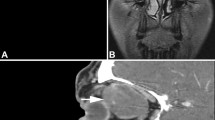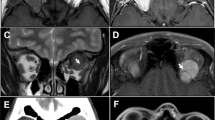Abstract
Background
SFTs are thought to have an unpredictable clinical course and currently have no recognized prognostic criterion. Our study aimed to determine the relationship between clinicopathological characteristics and the prognosis of patients with orbital SFTs.
Methods
The clinicopathological features of these patients were extracted from clinical records. The relationships between these features and prognosis were analysed.
Results
The positive rates of CD34, CD99, Blc2, and STAT6 expression were 90.3%, 90.3%, 83.9%, and 100%, respectively. The tumour recurrence rate was 38.7%. A higher recurrence rate was observed in patients with Ki67 index ≥ 5 (56.25% vs. 20%, P = 0.038).
Conclusion
A Ki67 index ≥ 5 was an effective parameter for predicting tumour recurrence of orbital SFTs. Close follow-up is needed for these patients.




Similar content being viewed by others
References
Klemperer P, Coleman BR (1992) Primary neoplasms of the pleura. A report of five cases. Am J Ind Med 22:1–31. https://doi.org/10.1002/ajim.4700220103
Olson NJ, Linos K (2018) Dedifferentiated solitary fibrous tumor: a concise review. Arch Pathol Lab Med 142:761–766. https://doi.org/10.5858/arpa.2016-0570-RS
Brunnemann RB, Ro JY, Ordonez NG, Mooney J, El-Naggar AK, Ayala AG (1999) Extrapleural solitary fibrous tumor: a clinicopathologic study of 24 cases. modern pathology : an official journal of the United States and Canadian Academy of Pathology. Inc 12:1034–1042
Shmuly T, Ben Zvi Y, Chaushu G, Kaplan I (2021) Oral solitary fibrous tumor: a retrospective clinico-pathological study and long-term follow-up. Medicina (Kaunas, Lithuania) 57. https://doi.org/10.3390/medicina57020152
Suster S, Nascimento AG, Miettinen M, Sickel JZ, Moran CA (1995) Solitary fibrous tumors of soft tissue. A clinicopathologic and immunohistochemical study of 12 cases. Am J Surg Pathol 19:1257–1266. https://doi.org/10.1097/00000478-199511000-00005
Carlos R, de Andrade BA, Canedo NH, Abrahão AC, Agostini M, de Almeida OP, Romañach MJ (2016) Clinicopathologic and immunohistochemical features of five new cases of solitary fibrous tumor of the oral cavity. Oral Surg Oral Med Oral Pathol Oral Radiol 121:390–395. https://doi.org/10.1016/j.oooo.2015.11.001
Kao YC, Lin PC, Yen SL, Huang SC, Tsai JW, Li CF, Tai HC, Lan J, Chuang IC, Yu SC, Huang HY (2016) Clinicopathological and genetic heterogeneity of the head and neck solitary fibrous tumours: a comparative histological, immunohistochemical and molecular study of 36 cases. Histopathology 68:492–501. https://doi.org/10.1111/his.12772
WHO (2020) WHO classification of tumours soft tissue and bone tumours, 5th edn. IARC Press, Lyon
Yao ZG, Wu HB, Hao YH, Wang XF, Ma GZ, Li J, Li JF, Lin CH, Zhong XM, Wang Z, Wang DZ (2019) Papillary solitary fibrous tumor/hemangiopericytoma: an uncommon morphological form with NAB2-STAT6 gene fusion. J Neuropathol Exp Neurol. https://doi.org/10.1093/jnen/nlz053
Thompson LDR, Liou SS, Feldman KA (2021) Orbit solitary fibrous tumor: a proposed risk prediction model based on a case series and comprehensive literature review. Head Neck Pathol 15:138–152. https://doi.org/10.1007/s12105-020-01184-6
England DM, Hochholzer L, McCarthy MJ (1989) Localized benign and malignant fibrous tumors of the pleura. A clinicopathologic review of 223 cases. Am J Surg Pathol 13:640–658. https://doi.org/10.1097/00000478-198908000-00003
Demicco EG, Park MS, Araujo DM, Fox PS, Bassett RL, Pollock RE, Lazar AJ, Wang WL (2012) Solitary fibrous tumor: a clinicopathological study of 110 cases and proposed risk assessment model. Mod Pathol : Off J United States Can Acad Pathol, Inc 25:1298–1306. https://doi.org/10.1038/modpathol.2012.83
Bahrami A, Lee S, Schaefer IM, Boland JM, Patton KT, Pounds S, Fletcher CD (2016) TERT promoter mutations and prognosis in solitary fibrous tumor. Mod Pathol : Off J United States Can Acad Pathol, Inc 29:1511–1522. https://doi.org/10.1038/modpathol.2016.126
Yamamoto Y, Hayashi Y, Murakami I (2020) Recurrence of solitary fibrous tumor/hemangiopericytoma could be predicted by Ki-67 regardless of its origin. Acta medica Okayama 74:335–343. https://doi.org/10.18926/amo/60372
Gold JS, Antonescu CR, Hajdu C, Ferrone CR, Hussain M, Lewis JJ, Brennan MF, Coit DG (2002) Clinicopathologic correlates of solitary fibrous tumors. Cancer 94:1057–1068
Stiller CA, Trama A, Serraino D, Rossi S, Navarro C, Chirlaque MD, Casali PG (2013) Descriptive epidemiology of sarcomas in Europe: report from the RARECARE project. Eur J Cancer (Oxford, England : 1990) 49:684–695. https://doi.org/10.1016/j.ejca.2012.09.011
Chan JK (1997) Solitary fibrous tumour–everywhere, and a diagnosis in vogue. Histopathology 31:568–576. https://doi.org/10.1046/j.1365-2559.1997.2400897.x
Harris GN, Rozenshtein A, Schiff MJ (1995) Benign fibrous mesothelioma of the pleura: MR imaging findings. AJR Am J Roentgenol 165:1143–1144. https://doi.org/10.2214/ajr.165.5.7572492
Ali MI, Aftab G, Akram A (2021) Solitary fibrous tumors of the pleura. Cureus 13:e12998. https://doi.org/10.7759/cureus.12998
Saifuddin A, Da Costa P, Chalmers AG, Carey BM, Robertson RJ (1992) Primary malignant localized fibrous tumours of the pleura: clinical, radiological and pathological features. Clin Radiol 45:13–17. https://doi.org/10.1016/s0009-9260(05)81459-x
Yang BT, Song ZL, Wang YZ, Dong JY, Wang ZC (2013) Solitary fibrous tumor of the sinonasal cavity: CT and MR imaging findings. AJNR Am J Neuroradiol 34:1248–1251. https://doi.org/10.3174/ajnr.A3485
Vogels RJ, Vlenterie M, Versleijen-Jonkers YM, Ruijter E, Bekers EM, Verdijk MA, Link MM, Bonenkamp JJ, van der Graaf WT, Slootweg PJ, Suurmeijer AJ, Groenen PJ, Flucke U (2014) Solitary fibrous tumor - clinicopathologic, immunohistochemical and molecular analysis of 28 cases. Diagn Pathol 9:224. https://doi.org/10.1186/s13000-014-0224-6
Doyle LA, Vivero M, Fletcher CD, Mertens F, Hornick JL (2014) Nuclear expression of STAT6 distinguishes solitary fibrous tumor from histologic mimics. Mod Pathol : Off J United States Can Acad Pathol, Inc 27:390–395. https://doi.org/10.1038/modpathol.2013.164
Fritchie KJ, Jin L, Rubin BP, Burger PC, Jenkins SM, Barthelmeß S, Moskalev EA, Haller F, Oliveira AM, Giannini C (2016) NAB2-STAT6 gene fusion in meningeal hemangiopericytoma and solitary fibrous tumor. J Neuropathol Exp Neurol 75:263–271. https://doi.org/10.1093/jnen/nlv026
Yang P, Liu HC, Qiu E, Wang W, Zhang JL, Jiang LB, Liu HG, Kang J (2021) Factors for postoperative recurrence of orbital solitary fibrous tumor: an analysis of long-term clinical follow-up results from a Chinese tertiary hospital. BMC Ophthalmol 21:61. https://doi.org/10.1186/s12886-021-01825-6
Wu T, Sun FY, Tang DR, Xu L (2013) The clinical analysis of cranio-orbital communicating tumors. [Zhonghua yan ke za zhi] Chin J Ophthalmol 49:531–535
Jian T, Sun F, Tang D, Wang S, Wu T, Zhao L (2015) Clinical analysis of transcranial orbitotomy approach on cranio-orbital tumors. J Craniofac Surg 26:441–446. https://doi.org/10.1097/scs.0000000000001346
Ohba S, Murayama K, Nishiyama Y, Adachi K, Yamada S, Abe M, Hasegawa M, Hirose Y (2019) Clinical and radiographic features for differentiating solitary fibrous tumor/hemangiopericytoma from meningioma. World neurosurgery 130:e383–e392. https://doi.org/10.1016/j.wneu.2019.06.094
He L, Li B, Song X, Yu S (2020) Signal value difference between white matter and tumor parenchyma in T1- and T2- weighted images may help differentiating solitary fibrous tumor/ hemangiopericytoma and angiomatous meningioma. Clin Neurol Neurosurg 198:106221. https://doi.org/10.1016/j.clineuro.2020.106221
Macagno N, Figarella-Branger D, Mokthari K, Metellus P, Jouvet A, Vasiljevic A, Loundou A, Bouvier C (2016) Differential diagnosis of meningeal SFT-HPC and meningioma: which immunohistochemical markers should be used? Am J Surg Pathol 40:270–278. https://doi.org/10.1097/pas.0000000000000526
Jackson CH, Hunt BC, Harris GJ (2021) Fate and management of incompletely excised solitary fibrous tumor of the orbit: a case series and literature review. Ophthalmic Plast Reconstr Surg 37:108–117. https://doi.org/10.1097/iop.0000000000001691
Stacchiotti S, Negri T, Libertini M, Palassini E, Marrari A, De Troia B, Gronchi A, Dei Tos AP, Morosi C, Messina A, Pilotti S, Casali PG (2012) Sunitinib malate in solitary fibrous tumor (SFT). Annals Oncol : Off J Eur Soc Med Oncol 23:3171–3179. https://doi.org/10.1093/annonc/mds143
Krengli M, Cena T, Zilli T, Jereczek-Fossa BA, De Bari B, Villa Freixa S, Kaanders J, Torrente S, Pasquier D, Sole CV, Lutsyk M, Dincbas FO, Habboush Y, Fariselli L, Dragan T, Baumert BG, Khanfir K, Ugurluer G, Thariat J (2020) Radiotherapy in the treatment of extracranial hemangiopericytoma/solitary fibrous tumor: study from the Rare Cancer Network. Radiother Oncol : J Eur Soc Ther Radiol Oncol 144:114–120. https://doi.org/10.1016/j.radonc.2019.11.011
Acknowledgements
We give thanks to all patients included in our study.
Author information
Authors and Affiliations
Contributions
Xiao-jin Gao and Wei-min He wrote the main manuscript text. Xiao-jin Gao and Xiao-lin Peng collected clinical data. Xiao-lin Peng and Yu-jiao Wang analysed these data. Wei-min He designed this research.
Corresponding author
Ethics declarations
Ethics approval
This research was approved by the institutional review board of West China Hospital, China.
Conflict of interest
The authors declare no competing interests.
Additional information
Publisher's note
Springer Nature remains neutral with regard to jurisdictional claims in published maps and institutional affiliations.
Rights and permissions
Springer Nature or its licensor holds exclusive rights to this article under a publishing agreement with the author(s) or other rightsholder(s); author self-archiving of the accepted manuscript version of this article is solely governed by the terms of such publishing agreement and applicable law.
About this article
Cite this article
Gao, Xj., Peng, Xl., Wang, Yj. et al. Orbital solitary fibrous tumours: clinicopathological characteristics and recurrence prediction. Graefes Arch Clin Exp Ophthalmol 261, 223–231 (2023). https://doi.org/10.1007/s00417-022-05795-3
Received:
Revised:
Accepted:
Published:
Issue Date:
DOI: https://doi.org/10.1007/s00417-022-05795-3




